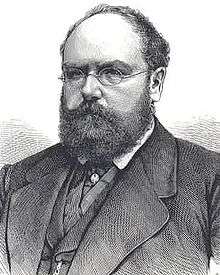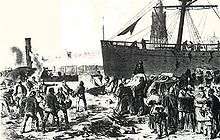Alexander Keith Jr.
Alexander Keith Jr. (1827–1875) was an American Civil War spy for the Confederate States of America. He used a time bomb to attempt to destroy the ship Mosel for insurance fraud.

Keith was born in 1827 in Caithness, Scotland, immigrating to Halifax when he was a small boy. The nephew of Halifax businessman Alexander Keith he worked for a time as a clerk in his uncle's brewery.
During the American Civil War Keith acted mostly as a blockade runner and courier. He helped a Confederate sympathiser escape British capture in the Chesapeake Affair. He was also involved with Luke Blackburn in a plot to send clothes infected with yellow fever to northern cities in the United States.[1]
In 1865, he swindled his associates-in-crime and fled to St. Louis, Missouri, settling finally on the prairie. There, he married Cecelia Paris, a milliner's daughter from St. Louis.

Hunted down by one of his victims, Keith fled again with Cecelia to Germany, hobnobbing with wealthy socialites and Saxon generals under the assumed name of "William King Thomas". When the couple began to run out of money, Keith concocted a plot to blow up passenger ships and collect the insurance money. This led to a major catastrophe in Bremerhaven, in 1875, when a time bomb he had placed in a shipping barrel accidentally went off on the dock, killing 40 to 80 people.[2] According to one witness: "A mushroom-shaped column of smoke rose approximately 200 meters above the harbor. Everywhere people were crying and whimpering beside ruins. The entire pier was covered in soot: it was like the gateway to hell." At the time, the deed was called the "crime of the century."
Keith was aboard another ship in Bremerhaven at the time of the Mosel explosion. He went to his suite and shot himself. He died a week later. After the tragedy was revealed as a murder/insurance scam on a large scale, the disappearances of other ships were investigated to see if Keith and his possible associates were involved. One was the disappearance of the SS City of Boston, which vanished in January 1870. The allegation was proven to be false.[3] He was reputed to have been buried in an unmarked grave in Bremerhaven. His severed head was kept at the Bremer Police Museum and was destroyed by Allied bombing in 1945. Newspapers called it "The Thomas Crime."
Regarding his time bomb, Keith's biographer Ann Larabee wrote: "Keith was not responsible for the political passion of these violent political groups, but he played a role in showing them a means of action."[4]
| Wikisource has original text related to this article: |
References
- John Davison Lawson, Robert Lorenzo Howard. "American State Trials: A Collection of the Important and Interesting," Trials. 1917, p. 72
- (in German) Deutsche Geschichte: Als die Höllenmaschine Bremerhaven erzittern ließ, Cord Christian Troebst, Der Spiegel, 7 augustus 2006
- Larabee p. 182
- Larabee p. 195
Sources
- Larabee, Ann (2005). The Dynamite Fiend: The Chilling Tale of a Confederate Spy, Con Artist, and Mass Murderer. Palgrave Macmillan. ISBN 9781403967947.
- Lotz, Pat (2002). Banker, Builder, Blockade Runner, A Victorian Embezzler and his Circle. Gaspereau Press. ISBN 9781894031646.